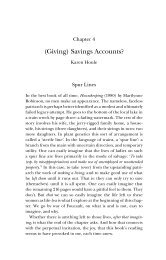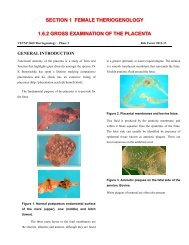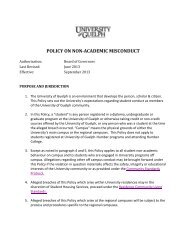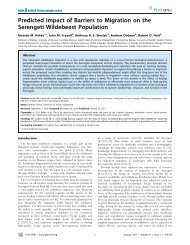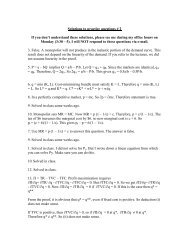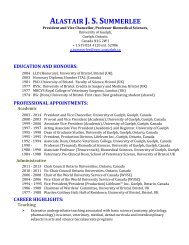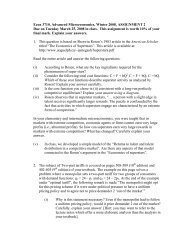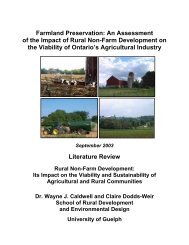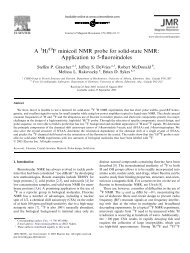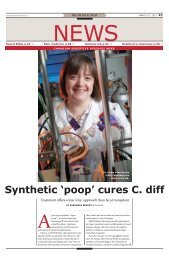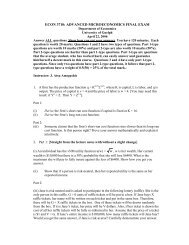The biology of Canadian weeds. 117. Taraxacum officinale G. H. ...
The biology of Canadian weeds. 117. Taraxacum officinale G. H. ...
The biology of Canadian weeds. 117. Taraxacum officinale G. H. ...
You also want an ePaper? Increase the reach of your titles
YUMPU automatically turns print PDFs into web optimized ePapers that Google loves.
early spring (Cyr et al. 1990). Fructans, storage carbohydrates<br />
such as inulin and inulo-n-ose, were synthesized in<br />
roots by the enzyme fructan-fructan fructosyl transferase<br />
(Lüscher et al. 1993; Ernst et al. 1996). This synthesis <strong>of</strong><br />
inulin was practically unaffected by the height <strong>of</strong> competing<br />
grass vegetation (Molgaard 1977). High inulin content in<br />
roots resulted in high nitrogenase activity (Vlassek and Jain<br />
1976), which could enrich the soil with nitrogen through<br />
asymbiotic nitrogen fixers such as Azotobacter and<br />
Clostridium species (Vlassek and Jain 1978). Fructan<br />
hydrolysis occurred during late autumn and provided simple<br />
sugars as a readily accessible carbon pool (Cyr et al. 1990).<br />
Nitrates, free amino acids and soluble proteins were important<br />
vehicles for nitrogen storage (Cyr et al. 1990). Storage<br />
reserves remained at peak levels throughout winter and<br />
declined prior to the resumption <strong>of</strong> growth in spring, when<br />
inulin was metabolized to provide a high content <strong>of</strong> mobile<br />
fructose and sucrose to enable extensive vegetative growth<br />
and flowering (Molgaard 1977; Cyr et al. 1990). At the time<br />
<strong>of</strong> fruiting, nitrogen reserves were at their lowest concentration<br />
(Loomis 1938). Toward the end <strong>of</strong> summer, these<br />
reserves were restored and the cycle began again<br />
(Rutherford and Deacon 1974).<br />
<strong>Taraxacum</strong> <strong>of</strong>ficinale was identified as a valuable source<br />
<strong>of</strong> the essential linolenic acid, apigenin-7-glucoside,<br />
lecithin, and cholin (Houghton 1995; Letchamo and<br />
Gosselin 1995). Unsaturated hydroxy fatty acids such as<br />
linolenic acid are important in the chilling-resistant properties<br />
<strong>of</strong> T. <strong>of</strong>ficinale (Imai et al. 1995).<br />
(d) Phenology. Generally, during the first season <strong>of</strong> growth,<br />
T. <strong>of</strong>ficinale seedlings produce only leaves, usually in<br />
rosettes (Longyear 1918). In the spring <strong>of</strong> the second season,<br />
and each season thereafter, inflorescences are produced<br />
(Longyear 1918). However, under favourable conditions,<br />
some seedlings can bloom in their first year (von H<strong>of</strong>sten<br />
1954; Listowski and Jackowska 1965). <strong>The</strong> first bud may<br />
appear at various times and cannot be correlated to leaf<br />
index, although the plant has to have formed at least 20<br />
leaves and enlarged its tap root to store the required energy<br />
(Listowski and Jackowska 1965; Solbrig 1971). <strong>The</strong> time <strong>of</strong><br />
first flowering is partly dependent on the surrounding plant<br />
community and, in undisturbed communities, a plant may<br />
not flower until its fourth season (Gorchakovskii and<br />
Abramchuk 1996).<br />
In T. <strong>of</strong>ficinale, flowering occurs over a wide range <strong>of</strong><br />
photoperiods and light intensities. Studies on seasonal variation<br />
in flowering <strong>of</strong> T. <strong>of</strong>ficinale in Kentucky, showed that<br />
plants flowered throughout the year, with most plants flowering<br />
in April when the average daily air temperature was<br />
16°C and day length was about 13 h. A secondary peak<br />
occurred in September and October, with an average <strong>of</strong><br />
21°C and 12–13 h day length (Gray et al. 1973). <strong>The</strong>refore,<br />
T. <strong>of</strong>ficinale can be classified as a day-neutral plant<br />
(Listowski and Jackowska 1965; Gray et al. 1973), although<br />
Solbrig (1971) classified it as a short-day plant due to limited<br />
flowering during long summer days. Individual plants<br />
that bloom in spring may also bloom again in fall (Listowski<br />
and Jackowska 1965). Bud formation in these plants occurs<br />
STEWART-WADE ET AL — TARAXACUM OFFICINALE G. H. WEBER EX WIGGERS 835<br />
during a period <strong>of</strong> decreasing daylight, when the differentiation<br />
<strong>of</strong> new leaves is limited and existing leaves show<br />
symptoms <strong>of</strong> premature aging (Listowski and Jackowska<br />
1965). <strong>The</strong> time course <strong>of</strong> the main spring flowering period<br />
may vary in different years, partly due to differences in<br />
microclimate, such as the amount <strong>of</strong> sunshine and soil temperature<br />
(von H<strong>of</strong>sten 1954; Sterk and Luteijn 1984). <strong>The</strong><br />
number <strong>of</strong> times the inflorescences open and close, the<br />
length <strong>of</strong> time that the inflorescences remain open each day,<br />
and the length <strong>of</strong> time that the inflorescences remain closed<br />
before opening into mature heads, vary with time <strong>of</strong> year<br />
(Gray et al. 1973).<br />
<strong>The</strong> development <strong>of</strong> buds requires approximately 1 wk<br />
(Solbrig 1971). A scape is formed between the base <strong>of</strong><br />
the bud and the tip <strong>of</strong> the shoot in about 48 h (Solbrig 1971).<br />
On average, inflorescences open during 2 or 3 successive<br />
days, after which they remain closed until the seeds mature<br />
(Longyear 1918; Gray et al. 1973). <strong>The</strong> scape and the<br />
inflorescence flatten to the ground and, after a couple <strong>of</strong><br />
days, the scape straightens and the involucral bracts surrounding<br />
the closed inflorescence open to reveal seeds<br />
(Solbrig 1971). <strong>The</strong> time required from the first day <strong>of</strong><br />
blooming until the seeds ripen and the bracts open to release<br />
them, is about 9–12 d (Longyear 1918; Beach 1939; Gray<br />
et al. 1973).<br />
A study in Japan showed that at low temperatures, inflorescences<br />
opened in response to increasing temperature<br />
(thermonasty), whereas at higher temperatures, they opened<br />
in response to light (photonasty) (Tanaka et al. 1988). <strong>The</strong><br />
minimum temperature for photonastic opening was 13°C<br />
and inflorescences remained open for 13–14 h (Tanaka et al.<br />
1988). At temperatures <strong>of</strong> 13–18°C, plants were in full<br />
bloom and this was most favourable for nectar secretion,<br />
pollen production and bee activity (Kremer 1950). In<br />
Michigan, USA, inflorescences were reported to close when<br />
the temperature was over 21°C or during adverse weather,<br />
and could remain closed for several days and then re-open<br />
when climatic conditions were favourable (Kremer 1950).<br />
Once closed, however, they did not open again on the same<br />
day (Kremer 1950).<br />
Seeds produced in the spring during the peak flowering<br />
period mostly emerged that same spring or did not emerge<br />
at all (Collins 2000). However, seeds produced at other<br />
times during the year produced seedlings throughout the<br />
year. Seedlings produced in the fall produced seeds in the<br />
spring <strong>of</strong> the following year. Chepil (1946) found that<br />
seedlings emerged in most months <strong>of</strong> the year in Canada and<br />
for up to 4 yr after sowing. Collins (2000) collected ripe,<br />
viable seeds from a single population on the University <strong>of</strong><br />
Western Ontario campus, London, ON, on the following<br />
dates in 1999: 1, 17, 27 May; 10 June; 20 August; 14, 21<br />
September; 4, 20 October; 5, 22 November; and 13<br />
December. At least 58% <strong>of</strong> the seeds collected on each date<br />
germinated. P. Cavers (personal communication, University<br />
<strong>of</strong> Western Ontario, London, ON) has collected ripe seeds in<br />
every month <strong>of</strong> the year, but not every month in a single<br />
year. He concluded that if there is a January or February<br />
thaw that lasts for at least a week, then flowering and seed<br />
production can occur.



